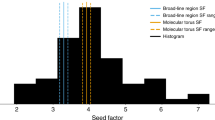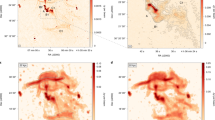Abstract
Recent X-ray observations have revealed that early-type galaxies (which usually produce extended double radio sources) generally have hot gaseous haloes extending up to ∼102kpc1,2. Moreover, much of the cosmic X-ray background radiation is probably due to a hotter, but extremely tenuous, intergalactic medium (IGM)3. We have presented4–7 an analytical model for the propagation of relativistic beams from galactic nuclei, in which the beams' crossing of the pressure-matched interface between the IGM and the gaseous halo, plays an important role. The hotspots at the ends of the beams fade quickly when their advance becomes subsonic with respect to the IGM. This model has successfully predicted (for typical double radio sources) the observed8 current mean linear-size (∼2D≃350 kpc)4,5, the observed8–11 decrease in linear-size with cosmological redshift4–6 and the slope of the linear-size versus radio luminosity10,12–14 relation6. We have also been able to predict the redshift-dependence of observed numbers and radio luminosities of giant radio galaxies7,15. Here, we extend this model to include the propagation of somewhat weaker beams. We show that the observed flattening of the local radio luminosity function (LRLF)16–20 for radio luminosity P≈ 1024 W Hz−1 at 1 GHz can be explained without invoking ad hoc a corresponding break in the beam power function Φ(Lb), because the heads of the beams with Lb < 1025 W Hz−1 are decelerated to sonic velocity within the halo itself, which leads to a rapid decay of radio luminosity and a reduced contribution of these intrinsically weaker sources to the observed LRLF.
This is a preview of subscription content, access via your institution
Access options
Subscribe to this journal
Receive 51 print issues and online access
$199.00 per year
only $3.90 per issue
Buy this article
- Purchase on Springer Link
- Instant access to full article PDF
Prices may be subject to local taxes which are calculated during checkout
Similar content being viewed by others
References
Forman, W., Jones, C. & Tucker, W. Astrophys. J. 293, 102–119 (1985).
Sarazin, C. L. Rev. Mod. Phys 58, 1–115 (1986).
Guilbert, P. W. & Fabian, A. C. Mon. Not. R. astr. Soc. 220, 439–451 (1986).
Gopal-Krishna & Wiita, P. J. Mon. Not. R. astr. Soc. 226, 531–542 (1987).
Wiita, P. J. & Gopal-Krishna, in 13th Texas Symposium on Relativistic Astrophysics (ed. Ulmer, M. P.) 355–357 (World Scientific, Singapore, 1987).
Rosen, A. & Wiita, P. J. Astrophys. J. (in the press).
Gopal-Krishna, Wiita, P. J. & Saripalli, L. Mon. Not. R. astr. Soc. (submitted).
Kapahi, V. K. Mon. Not. R. astr. Soc. 214, 19–23 (1985).
Eales, S. A. Mon. Not. R. astr. Soc. 217, 179–203 (1985).
Oort, M. J. A., Katgert, P., Steeman, F. W. H. & Windhorst, R. A. Astr. Astrophys. 179, 41–59 (1987).
Singal, A. K. Mon. Not. R. astr. Soc (in the press).
Gavazzi, G. & Perola, G. C. Astr. Astrophys. 66, 407–416 (1978).
Ekers, R. D., Fanti, R., Lari, C. & Parma, P. Astr. Astrophys. 101, 194–214 (1981).
Kapahi, V. K. in Highlights of Astronomy (ed. Swings, J. P.) Vol. 7, 371–376 (Reidel, Dordrecht, 1986).
Saripalli, L., Gopal-Krishna, Reich, W. & Kühr, H. Astr. Astrophys. 170, 20–26 (1986).
Auriemma, C. et al. Astr. Astrophys. 57, 41–50 (1977).
Meier, D. L., Ulrich, M.-H., Fanti, R., Gioia, I. & Lari, C. Astrophys. J. 229, 25–38 (1979).
Windhorst, R. A. Thesis. Univ. Leiden (1984).
Cordey, R. A. Mon. Not. R. astr. Soc 219, 575–588 (1986).
Subrahmanya, C. R. & Harnett, J. I. Mon. Not. R. astr. Soc. 225, 297–306 (1987).
Trinchieri, G. in Gaseous Halos of Galaxies (eds Bregman, J. N. & Lockman, F. J.), 215–221 (NRAO, Green Bank, 1986).
Scheuer, P. A. G. in Superluminal Radio Sources (eds Zensus, J. A. & Pearson, T. J.) 104–113 (Cambridge University Press, 1987).
Gopal-Krishna, & Saripalli, L. Astr. Astrophys. 139, L19–L21 (1984).
Dreher, J. W. in Physics of Energy Transport in Extragalactic Radio Sources (eds Bridle, A. H. & Eilek, J. A., 109–113 (NRAO, Green Bank, 1984).
Saripalli, L. & Gopal-Krishna Astr. Astrophys. 149, 205–208 (1985).
Rees, M. J. & Setti, G. Nature 219, 127–131 (1966).
van der Laan, H. & Perola, G. C. Astr. Astrophys. 3, 468–476 (1969).
Miley, G. K. A. Rev. Astr. Astrophys. 18, 165–218 (1980).
Bridle, A. H. Can. J. Phys. 64, 353–361 (1986).
Wiita, P. J. Astrophys. J. 221, 436–448 (1978).
Smith, M. D., Smarr, L., Norman, M. L. & Wilson, J. R. Astrophys. J. 264, 432–445 (1983).
Killeen, N. E. B., Bicknell, G. V. & Ekers, R. D. Astrophys. J. (in the press).
Fabbiano, G., Klein, U., Trinchieri, G. & Wielebinski, R. Astrophys. J. (submitted).
Lilly, S. J. & Prestage, R. M. Mon. Not. R. astr. Soc. 225, 531–550 (1987).
Heckman, T. M. et al. Astrophys. J. 311, 526–547 (1986).
Author information
Authors and Affiliations
Rights and permissions
About this article
Cite this article
Gopal-Krishna, Wiita, P. Hot gaseous coronae of early-type galaxies and their radio luminosity function. Nature 333, 49–51 (1988). https://doi.org/10.1038/333049a0
Received:
Accepted:
Issue Date:
DOI: https://doi.org/10.1038/333049a0
This article is cited by
-
The physics of E × B-drifting jets
Journal of Astrophysics and Astronomy (2004)
Comments
By submitting a comment you agree to abide by our Terms and Community Guidelines. If you find something abusive or that does not comply with our terms or guidelines please flag it as inappropriate.



